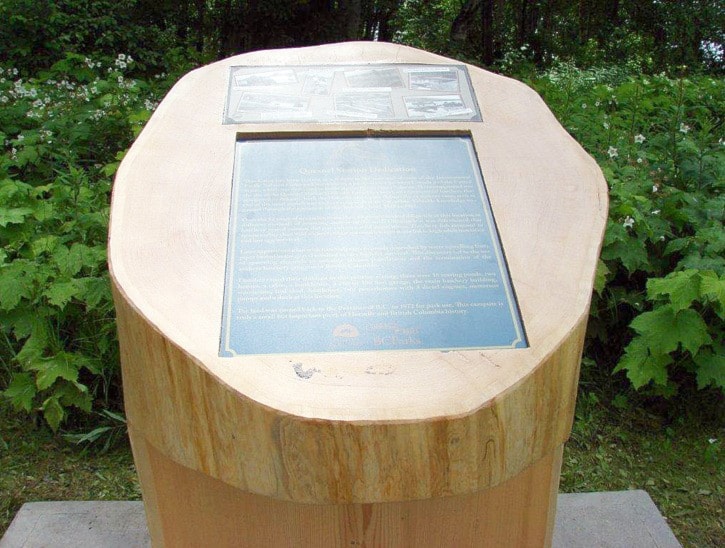On Nov. 12, 2010 I e-mailed my friend Stan Hembrough that I had an idea for a project.
This idea was to build some kind of commemorative cairn to honour the people who built and worked at the old hatchery where we grew up together in the 1950s.
We both lamented that this was a piece of history no one even knew about anymore, including newer residents of Horsefly, some DFO staff, B.C. Parks, and the general public who camped there now.
Gerri Teppema, who has been taking care of the park since it opened more than 30 years ago, had mentioned numerous times that people were always asking her about the hatchery, and to this end I had written a short history of the Horsefly Lake Provincial Campground (since shortened to Horsefly Lake Park).
This is too bulky to pass around and there is one copy in the Horsefly Library, and one in the Jack Lynn Memorial Museum.
The idea of a cairn with the names of all the people who took part in the venture seemed OK until I began compiling names, and realized it would not be possible to remember everyone.
The only people still alive today who were involved in the exploration, road building and construction and working at the hatchery are Jim Mason, an American biologist who is 93; Texas Fosbery, who built the road to the hatchery and is about 83; and Bill and Ruby Reid (80s) who clipped dorsal fins.
There are quite a few younger people who were part of Fisheries staff in the spawning season that are still alive, but pretty well all of the pioneers are gone.
I took the idea to the Horsefly Historical Society of which I am a member, and it thought it was a great idea, but we had no funds.
I went home and looked into every possible source of funding available.
In most cases, there is no funding for commemorative cairns. I lost track of how many different organizations rejected the idea.
Sometime during the winter after another rejection, I managed to contact B.C. Parks area supervisor Heather Gorrell and ran the idea by her.
Gorrell actually thought it was a good idea and had no idea the Quesnel Station ever existed.
She drove to Horsefly and picked up my historical article from the library, read it, and it wasn’t long before she obtained a small grant from B.C. Parks for the idea to coincide with a July 16, 100th year’s event at the park.
The grant was not enough to cover all the expenses, so more funding was needed.
The Horsefly River Roundtable put in for a grant that most of the knowledgeable grant people thought stood a good chance. We would not know the results until June 30, and then the long July 1 weekend before we would know for certain. The application failed (probably the cairn thing), and now we were faced with a dilemma — to cancel or go ahead?
If we went ahead with the project, we would have hardly anything to pay our log carver. I contacted Ray LeBourdais and told him the problem.
I told him that after we had paid for the plaque, photo layout for the cairn, and birthday cake, he could make a bill up for the change, and we would do our level best to square up with him some day. He agreed, so the next person down the line, Beat Oschwald, who we got to do the concrete slab for the cairn, was now a volunteer.
I supplied the concrete, rebar, varathane, mounting rods, and wood preservative.
Bob Bartsch welded the mounts for the cairn to plates he supplied, to go under the pad, and Ron Teppema was recruited to lift the cairn from Ray’s truck with his tractor, and drop it on the mounts. Tom Foley was to mount the plaque facsimile and photo layout the morning of July 16, right after the cairn was set up.
Due to hand mixing the cement for the pad, Beat Oschwald needed at least a three- or four-hour window with no torrential downpours, otherwise he would have soup instead of cement.
It was Thursday, July 14 before this window occurred and the pad was successfully completed.
I can’t say enough good things about the people who helped and were part of this project: Gorrell and B.C. Parks for the funding and initiative, Tom Foley for the plaque design and photo layout, Ray LeBourdais for carving a lasting legacy to a historical landmark, and Beat Oschwald for pouring the cement pad at the location Teppema selected.
For me, the most difficult challenge was to select wording for the plaque the average lay person could understand and yet satisfy the scientific and biologic history of the event accurately.
The words on the plaque are the product of input from John Roos, author of Restoring the Fraser River Salmon; Judy Hillaby, a first-rate biologist and our DFO representative on the roundtable; Stan Hembrough, who grew up and worked at the hatchery; and finally Cathy Koot, a writer who corrected my fractured grammar to the point where it made sense.
The Pacific Salmon Commission graciously provided permission to use some photos from Roos’ book in the photo layout; the others are from my photo gallery.
Speedpro Signs is supplying the permanent bronze plaque for the cairn.
The cairn was installed during a special commemorative ceremony on July 16 and is something of which all of us who were part of can be extremely proud.
